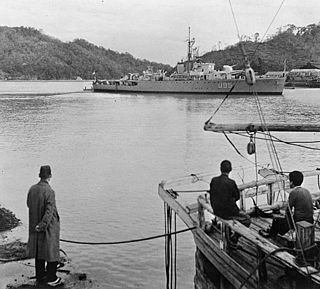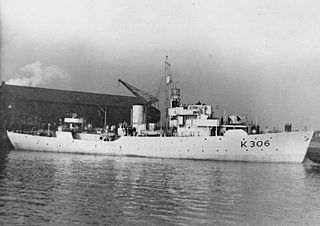This page is based on this
Wikipedia article Text is available under the
CC BY-SA 4.0 license; additional terms may apply.
Images, videos and audio are available under their respective licenses.

INS Delhi was a Leander-class light cruiser built for the Royal Navy in 1933 as HMS Achilles, and commissioned into the New Zealand Division of the Royal Navy in 1937 as HMNZS Achilles. She was returned to the Royal Navy at the end of the Second World War and in 1948 was sold to the Royal Indian Navy to be recommissioned as HMIS Delhi. In 1950 she was renamed INS Delhi and remained in service until decommissioned at Bombay on 30 June 1978.

The Royal Indian Navy (RIN) was the naval force of British India and the Dominion of India. Along with the Presidency armies, later the Indian Army, and from 1932 the Indian Air Force, it was one of the Armed Forces of British India.
Dominant powers in present-day India have possessed navies for many centuries. Pre-colonial dynasties such as the Cholas used naval power to extend Indian trade and influence overseas, particularly to Southeast Asia. The Maratha Navy of the 17th and 18th centuries fought against British and Portuguese colonisers. The British East India Company organised its own navy, later known as the Bombay Marine. With the establishment of the British Raj during the 19th century the naval force became "His Majesty's Indian Navy", then "Her Majesty's Indian Marine", and finally the "Royal Indian Marine". This navy transported large numbers of Indian troops overseas during World War I, and – as the Royal Indian Navy – took part in combat and protected communications during World War II. When India became independent in 1947 part of the Royal Indian Navy was allotted to the new state of Pakistan; the remaining Indian force took the title of Indian Navy in 1950. The Indian Navy took part in the annexation of Goa in 1961, in wars with Pakistan in 1965 and 1971, and in more recent smaller-scale operations.
The Royal Indian Navy revolt encompasses a total strike and subsequent revolt by Indian sailors of the Royal Indian Navy on board ship and shore establishments at Bombay harbour on 18 February 1946. From the initial flashpoint in Bombay, the revolt spread and found support throughout British India, from Karachi to Calcutta, and ultimately came to involve over 20,000 sailors in 78 ships and shore establishments.
A number of ships of the Royal Navy have borne the name Bombay, after the Indian city of Bombay, now Mumbai. Among them were:
A few ships of the British Royal Navy have borne the name HMS Zenobia, named after Zenobia, the Queen of the Palmyrene Empire who conquered Egypt.
HMIS Narbada (U40) was a Modified Bittern class sloop, later known as the Black Swan class, which served in the Royal Indian Navy (RIN) during World War II.

HMIS Sutlej (U95) was a modified Bittern-class sloop, later known as the Black Swan class, which served in the Royal Indian Navy (RIN) during World War II.
HMIS Kistna (U46) was a Black Swan class sloop which served in the Royal Indian Navy (RIN) during World War II.
HMIS Tir was a River-class frigate of the Royal Indian Navy (RIN). She was acquired from the Royal Navy where she served as HMS Bann during World War II. She was commissioned into the RIN in December 1945.
HMIS Cauvery, pennant number U10, was a Black Swan-class sloop which served in the Royal Indian Navy (RIN) during World War II.

HMIS Assam was a World War II Flower-class corvette of the Royal Indian Navy. She was originally ordered for and commissioned as HMS Bugloss of the Royal Navy, but transferred to the Royal Indian Navy immediately upon commissioning. She was transferred back to the Royal Navy in 1947 and subsequently scrapped.
HMS Betony was a Flower-class corvette of the Royal Navy. She was ordered in 1941, and commissioned in August 1945. She was immediately transferred to the Royal Indian Navy, where she was commissioned as HMIS Sind. She was transferred back to the Royal Navy in May 1946, as the war ended just days after her transfer. She was then sold to the Royal Thai Navy in 1947 as HTMS Prasae, and eventually scuttled in 1951.

HMIS Hindustan (L80) was a Folkestone-class sloop which served in the Royal Indian Navy (RIN) during World War II. Her pennant number was changed to U80 in 1940.
HMIS Gondwana was a World War II Flower-class corvette of the Royal Indian Navy (RIN). She was originally ordered for and commissioned as HMS Burnet of the Royal Navy, but transferred to RIN immediately upon commissioning.
HMIS Lawrence (L83) was a sloop, commissioned in 1919 into the Royal Indian Marine (RIM).

INS Shivaji is an Indian Naval station located in Lonavala, Maharashtra, India. It houses the Naval College of Engineering which trains officers of the Indian Navy and the Indian Coast Guard. It was commissioned on 15 February 1945 as HMIS Shivaji. It is located close to the Bhushi Dam. It is located on 876 acres of land.









